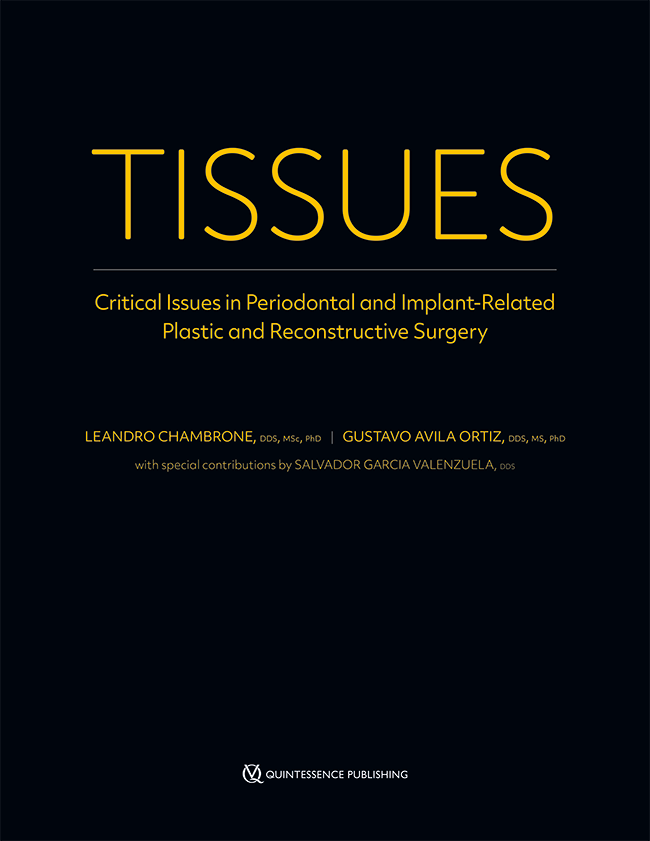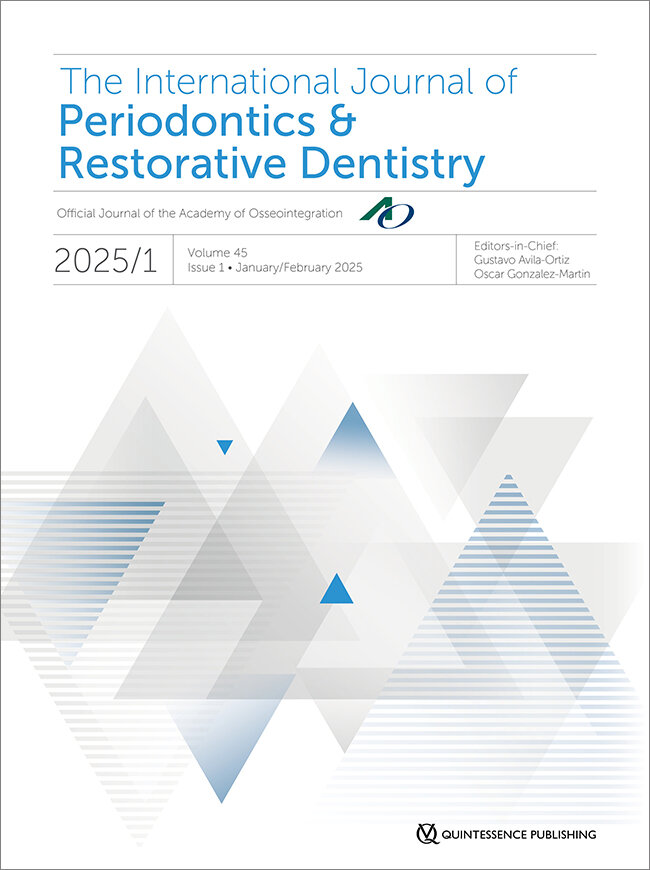International Journal of Periodontics & Restorative Dentistry, Pre-Print
DOI: 10.11607/prd.7265, PubMed ID (PMID): 3905894126. Jul 2024,Pages 1-23, Language: EnglishRodrigues, Diogo Moreira / Avila-Ortiz, Gustavo / Barboza, Eliane Porto / Chambrone, Leandro / Fonseca, Manrique / Couso-Queiruga, EmilioThis study aimed at characterizing the gingival thickness (GT) and determining correlations with other local phenotypical features. Cone-beam computed tomography scans from adult subjects involving the maxillary anterior teeth were obtained to assess buccal GT at different apico-coronal levels, periodontal supracrestal tissue height (STH), the distance from the cementoenamel junction to the alveolar bone crest (CEJ-BC), and bucco-lingual tooth dimensions in mm. A total of 100 subjects and 600 maxillary anterior teeth constituted the study sample. Variations in mean values of GT were observed as a function of apico-coronal level, tooth type, and gender. GT progressively increased apically. Maxillary central incisors and males generally exhibited thicker GT. Contrarily, females exhibited thinner GT and shorter STH. Tooth dimensions were negatively correlated with GT, as the narrower the tooth crown/root in the bucco-lingual dimension, the thicker the gingiva. GT at the level of the CEJ was dichotomized to differentiate between thin (<1mm) and thick (≥1mm) gingival phenotypes (GP). Teeth with a thin GP displayed greater CEJ-BC and buccolingual tooth width dimensions. Conversely, teeth with a thick GP generally exhibited taller STH and narrower tooth dimensions.
International Journal of Periodontics & Restorative Dentistry, Pre-Print
DOI: 10.11607/prd.7217, PubMed ID (PMID): 3943672922. Oct 2024,Pages 1-28, Language: EnglishCouso-Queiruga, Emilio / López del Amo, Fernando Suárez / Avila-Ortiz, Gustavo / Chambrone, Leandro / Monje, Alberto / Galindo-Moreno, Pablo / Garaicoa- Pazmino, CarlosThis PRISMA-compliant systematic review aimed to investigate the effect of supportive peri- implant care (SPIC) on peri-implant tissue health and disease recurrence following the non surgical and surgical treatment of peri-implant diseases. The protocol of this review was registered in PROSPERO (CRD42023468656). A literature search was conducted to identify investigations that fulfilled a set of pre-defined eligibility criteria based on the PICO question: what is the effect of SPIC upon peri-implant tissue stability following non-surgical and surgical interventions for the treatment of peri-implant diseases in adult human subjects? Data on SPIC (protocol, frequency, and compliance), clinical and radiographic outcomes, and other variables of interest were extracted and subsequently categorized and analyzed. A total of 8 studies, with 288 patients and 512 implants previously diagnosed with peri-implantitis were included. No studies including peri-implant mucositis fit the eligibility criteria. Clinical and radiographic outcomes were similar independently of specific SPIC features. Nevertheless, a 3-month recall interval was generally associated with a slightly lower percentage of disease recurrence. The absence of disease recurrence at the final follow-up period (mean of 58.7±25.7 months) ranged between 23.3% and 90.3%. However, when the most favorable definition of disease recurrence reported in the selected studies was used, mean disease recurrence was 28.5% at baseline, considered 1 year after treatment for this investigation, and increased to 47.2% after 2 years of follow-up. In conclusion, regardless of the SPIC interval and protocol, disease recurrence tends to increase over time after the treatment of peri-implantitis, occasionally requiring additional interventions.
Keywords: dental implants; peri-implantitis; peri-implant mucositis; disease progression; risk factors
International Journal of Periodontics & Restorative Dentistry, 1/2025
DOI: 10.11607/prd.6935, PubMed ID (PMID): 37819850Pages 115-133j, Language: EnglishGaraicoa-Pazmino, Carlos / Couso-Queiruga, Emilio / Monje, Alberto / Avila-Ortiz, Gustavo / Castilho, Rogerio M. / Amo, Fernando Suárez López delThe aim of this PRISMA-compliant systematic review was to analyze the evidence pertaining to disease resolution after the treatment of peri-implant diseases with the following PICO question: What is the rate of disease resolution following nonsurgical and surgical therapy for peri-implant diseases in adult human subjects? A literature search to identify studies that fulfilled preestablished eligibility criteria was conducted. Data on primary therapeutic outcomes, including treatment success and rate of disease resolution and/or recurrence, as well as a variety of secondary outcomes were extracted and categorized. A total of 54 articles were included. Few studies investigated the efficacy of different nonsurgical and surgical therapies to treat peri-implant diseases using a set of predefined criteria and with follow-up periods of at least 1 year. The definition of treatment success and disease resolution outcomes differed considerably among the included studies. Peri-implant mucositis treatment was most commonly reported to be successful in arresting disease progression for ≤ 60% of the cases, whereas most studies on peri-implantitis treatment reported disease resolution occurring in < 50% of the implants. Disease resolution is generally unpredictable and infrequently achieved after the treatment of peri-implant diseases. A great variety of definitions have been used to define treatment success. Notably, percentages of treatment success and disease resolution were generally underreported. The use of standardized parameters to evaluate disease resolution should be considered an integral component in future clinical studies.
Keywords: dental implant, diagnosis, peri-implant endosseous healing, peri-implantitis, outcome assessment, tooth loss
International Journal of Periodontics & Restorative Dentistry, 6/2024
DOI: 10.11607/prd.6879, PubMed ID (PMID): 37655973Pages 629-638b, Language: EnglishCouso-Queiruga, Emilio / Avila-Ortiz, Gustavo / Barboza, Eliane Porto / Chambrone, Leandro / Keceli, Huseyn Gencay / Yilmaz, Birtain Tolga / Rodrigues, Diogo MoreiraThis study aimed to determine the correlation between gingival stippling (GS) and other phenotypic characteristics. Adult subjects in need of CBCT scans and comprehensive dental treatment in the anterior maxilla were recruited. Facial gingival thickness (GT) and buccal bone thickness (BT) were assessed utilizing CBCT. Standardized intraoral photographs were obtained to determine keratinized tissue width (KTW), presence of GS in all facial and interproximal areas between the maxillary canines, and other variables of interest, such as gingival architecture (GA), tooth shape, and location. Statistical analyses were conducted to assess different correlations among recorded variables. A total of 100 participants and 600 maxillary anterior teeth constituted the study population and sample, respectively. Facial GS was observed in 56% of men and 44% of women, and it was more frequently associated with flat GA, triangular and square/tapered teeth, central incisors, and men. Greater mean GT, BT, and KTW values were observed in facial areas that exhibited GS. Interdental GS was present in 73% of the sites, and it was more frequently observed in men, in the central incisor region, and when facial GS was present. Multilevel logistic regression revealed a statistically significant association between the presence of GS and KTW, BT measured at 3 mm apical to the bone crest, and tooth type. This information can be used to recognize common periodontal phenotypical patterns associated with specific features of great clinical significance.
Keywords: dentition, gingiva, oral mucosa, periodontium, permanent, phenotype
International Journal of Periodontics & Restorative Dentistry, 6/2024
DOI: 10.11607/prd.2024.6.e, PubMed ID (PMID): 39546731Pages 622, Language: EnglishAvila-Ortiz, GustavoEditorial International Journal of Periodontics & Restorative Dentistry, 5/2024
DOI: 10.11607/prd.6809, PubMed ID (PMID): 37471159Pages 520-533, Language: EnglishCouso-Queiruga, Emilio / Garaicoa-Pazmino, Carlos / Fonseca, Manrique / Chappuis, Vivianne / Gonzalez-Martin, Oscar / Avila-Ortiz, GustavoThe primary aim of this study was to evaluate the efficacy of alveolar ridge preservation (ARP) ther- apy compared with unassisted socket healing (USH) in attenuating interproximal soft tissue atrophy. Adult patients who underwent maxillary single-tooth extraction with or without ARP therapy were included. Surface scans were obtained and CBCT was performed to digitally assess interproximal soft tissue height changes and measure facial bone thickness (FBT), respectively. Logistic regres- sion models were conducted to investigate the individual effect of demographic and clinical vari- ables. Ninety-six subjects (USH = 49; ARP = 47) constituted the study population. Linear soft tissue assessments revealed a significant reduction of the interproximal soft tissue over time within and between groups (P < .0001). ARP therapy significantly attenuated interproximal soft tissue height re- duction compared to USH: –2.0 ± 0.9 mm mesially for USH vs –1.0 ± 0.5 mm mesially for ARP; –1.9 ± 0.7 mm distally for USH vs –1.1 ± 0.5 mm distally for ARP (P < .0001). Thin (≤ 1 mm) facial bone thick- ness (FBT) upon extraction was associated with greater interproximal soft tissue atrophy compared to thick FBT (> 1 mm), independent of the treatment received (P < .0001). Nevertheless, ARP therapy resulted in better preservation of interproximal soft tissue height, especially in thin bone phenotype, by a factor of 2 for the mesial site (+1.3 mm) and by a factor of 1.6 for the distal site (+0.9 mm). This study demonstrated that ARP therapy largely attenuates interproximal soft tissue dimensional re- duction after maxillary single-tooth extraction compared to USH.
Keywords: alveolar ridge preservation, bone resorption, dental implants, digital image processing, tooth extraction
International Journal of Periodontics & Restorative Dentistry, 4/2024
DOI: 10.11607/prd.2024.4.ePages 375, Language: EnglishAvila-Ortiz, Gustavo / Pini Prato, Giovan Paolo / Gonzalez-Martin, OscarEditorial International Journal of Periodontics & Restorative Dentistry, 3/2024
DOI: 10.11607/prd.2024.3.c, PubMed ID (PMID): 38787713Pages 252-255, Language: EnglishBrown, Evans / Stuhr, Sandra / Chambrone, Leandro / Childs, Christopher A. / Avila-Ortiz, Gustavo / Elangovan, SatheeshCommentaryClinicians, researchers, and policymakers often rely on the available scientific evidence to make strategic decisions. Systematic reviews (SRs) occupy an influential position in the hierarchy of scientific evidence. The findings of wellconducted SRs may provide valuable information to answer specific research questions1,2 and identify existing gaps for future research.3 Therefore, it is of supreme importance that SRs are published promptly, reducing as much as possible the time elapsed between the last date of the search for primary studies and the actual publication date. A study published in 2014 assessed the publication delay of SRs in orthodontics, revealing that the median time interval from the last search to publication was more than 1 year (13.2 months).4 Delays in the publication of SRs or original research articles may depend on author-related factors (eg, timing of resubmission after receiving feedback from reviewers) or journal-related factors (eg, time taken to process a submission).5–7 Regardless of the reasons, clinical recommendations and translation of SR findings may be affected by publication delay. We assessed the extent of publication delay of systematic reviews in dentistry with the purpose of addressing its implications and presenting potential solutions.
International Journal of Periodontics & Restorative Dentistry, 2/2024
DOI: 10.11607/prd.2024.2.e1, PubMed ID (PMID): 38507398Pages 139-141, Language: EnglishStevens, Clinton D. / Avila-Ortiz, GustavoEditorialInternational Journal of Periodontics & Restorative Dentistry, 1/2024
DOI: 10.11607/prd.2024.1.e, PubMed ID (PMID): 38265357Pages 7, Language: EnglishAvila-Ortiz, Gustavo / Gonzalez-Martin, OscarEditorial




